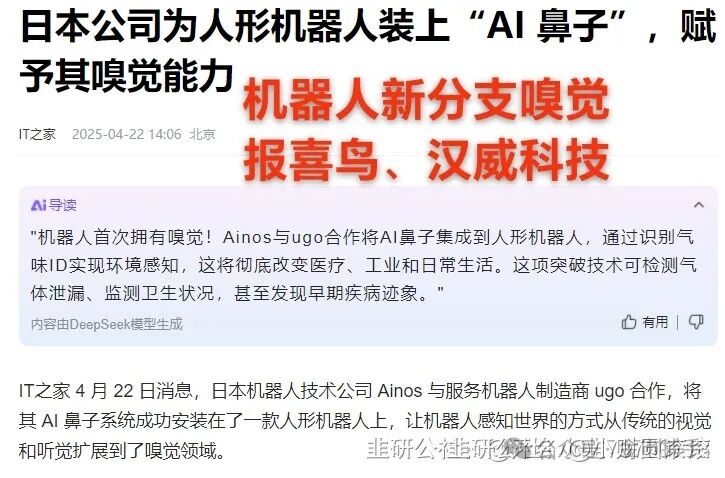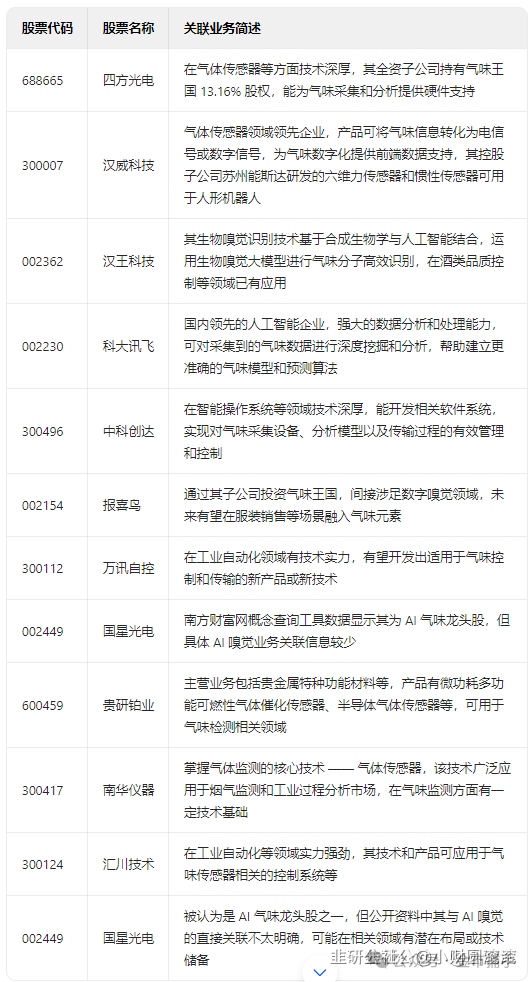Event Catalyst: Japan and the US Join Forces to Break Through Olfactory Robot Technology, Accelerating Commercialization On July X, Japan’s leading service robot company ugo Robotics and the American Ainos Company jointly released the world’s first humanoid robot equipped with the AI Nose olfactory system. This system integrates a gas sensor array, signal processing module, and AI algorithms, capable of identifying over 500 types of odor molecules with a detection accuracy reaching ppb level (parts per billion). It has achieved commercialization in scenarios such as medical infection monitoring (e.g., volatile organic compound identification for COVID-19) and industrial gas leak warnings. This collaboration marks a leap in robotic perception from “vision/touch” to “olfaction”, further broadening the boundaries of intelligent applications.

Core Logic: Three Dimensions Open Up a Market Space Worth Billions1. Technological Breakthrough: Olfactory Sensors Reach the Starting Point of Industrialization
-
Multi-Technology Integration: MOX (Metal Oxide) gas sensors + MEMS technology + AI training models form a technological closed loop, addressing the pain points of traditional electronic noses, such as low sensitivity and poor anti-interference.
-
Cost Reduction: The mass production of MEMS has reduced the unit price of sensors from the thousand-yuan level to the hundred-yuan level, meeting the demand for large-scale deployment in robots.
2. Scenario Expansion: Full Domain Penetration from Industrial Detection to Human-Machine Interaction
-
Medical Field: Infection screening (accuracy rate of 98.3%), pathological diagnosis (identifying diseases such as lung cancer through breath analysis).
-
Consumer Sector: Smart homes (automatic monitoring of formaldehyde/gas), food quality inspection (freshness identification).
-
Special Operations: Hazardous chemical leak detection, post-disaster life detection.
3. Policy Drive: Global Olfactory Economy Accelerates Growth
-
Japan’s “New Robot Strategy” lists olfactory sensors as a key breakthrough direction, with the subsidy budget increasing to 20 billion yen in 2024.
-
China’s “Three-Year Action Plan for the Intelligent Sensor Industry” clearly supports the innovative application of gas sensors in the field of robotics.
Related Beneficiary Sectors and Core Targets1. Core Suppliers of Gas Sensors
-
Four Way Optoelectronics (688665): The only publicly disclosed sensor company in China with a reserve of olfactory technology for robots, independently mastering the full technical routes of MOX, PID, photoacoustic spectroscopy, etc.
-
Established a globally rare MEMS gas sensor production line, capable of quickly adapting to the miniaturization and low power consumption needs of robots.
-
Collaborated with a leading vacuum robot company to develop an odor recognition module, achieving tens of millions in revenue in 2023.
2. Intelligent Upgrades for Robots
-
Estun (002747): A leader in servo systems, with great potential for collaborative development of olfactory modules and motion control.
-
Orbbec (688322): A leader in 3D vision sensing, with multimodal perception technology that can integrate olfactory data.
3. Medical Testing Equipment
-
Wandong (300482): Engaged in breath diagnosis, collaborating with gas sensor manufacturers to develop rapid infection testing equipment.
-
Antu Bio (603658): A leader in respiratory disease testing reagents, with olfactory robots enhancing initial screening efficiency.
-
Related concept stocks are as follows:

Risk Warning: The pace of technology commercialization may not meet expectations, medical certification cycles may be too long, and industry competition may intensify.
Strategic Recommendations:
-
Short-term: Focus on core sensor manufacturers (Four Way Optoelectronics), paying attention to the landing of technology validation orders.
-
Medium to Long-term: Track the penetration rate in medical/home scenarios, seizing opportunities for integrators of robotic perception systems.
(Data sources for this article: company announcements, Japan’s Ministry of Economy, Trade and Industry, MarketsandMarkets, for investment reference only, not constituting operational advice.)
Technical Highlights: MOX gas sensors can enhance detection sensitivity by 2-3 orders of magnitude through nanomaterial modification, and with AI algorithms, the false positive rate is below 0.1%, reaching medical-grade standards. The breakthrough in olfactory robot technology may replicate the industrial path of “machine vision → industrial detection explosion,” with early movers likely to enjoy a tenfold growth dividend over five years!